July 25, 2008
Air Date: July 25, 2008
FULL SHOW
SEGMENTS
Arctic Gender Imbalance
View the page for this story
Only girls are being born in a village in Greenland. Host Steve Curwood turns to Lars Otto Reiersen, of the Arctic Monitoring and Assessment Program, to find out what may be behind a growing gender imbalance in babies born around the Arctic Circle. (05:00)
From Toilet to Tap
/ Ingrid LobetView the page for this story
Los Angeles recently announced it will begin recycling sewage waters into drinking water using advanced treatment. LA is following the lead of Orange County, CA, which earlier this year opened the most advanced such system in the country. Living on Earth’s Ingrid Lobet reports in this piece. (06:30)
Northwest Dead Zone
View the page for this story
There are about 200 oxygen depleted regions, or dead zones, in the world’s oceans. They occur when fertilizers and manure in runoff reach the sea, fueling algae that eats up all the oxygen. But a dead zone off the coast of the Pacific Northwest has scientists looking at a different culprit – climate change. Host Steve Curwood turns to Professor Jack Barth of Oregon State University to learn more about what might be behind the dead zone in the Northwest. (06:00)
Dial-A-Fish
/ Ashley AhearnView the page for this story
When you’re in the supermarket or ordering fish at a restaurant, ever have trouble remembering which species has high mercury, which is overfished, and which is the most sustainable? Now, a new text messaging service can tell you everything you need to know, whether one fish, two fish, red fish or blue fish. Living on Earth’s Ashley Ahearn takes her cell phone to a local market to find out how the Fish Phone works. (03:30)
Interpreting History
/ Jim WilliamsView the page for this story
African American Park Ranger Shelton Johnson channels Sergeant Alizy Bowman, bringing back a Buffalo Soldier who helped guard Yosemite National Park just after its creation. Producer Jim Williams went to the park and has our profile. (08:30)
Global Weirding
View the page for this story
Listeners suggest alternatives for the terms “global warming” and “climate change,” which are both common, but not quite correct. How about human consumption climate disruption? (02:15)
Life As a Locavore
View the page for this story
Author Barbara Kingsolver recounts eating locally grown food for a year in the book “Animal, Vegetable, Miracle: A Year of Food Life.” She talks to Steve Curwood about why food has become a public issue, the challenges of finding local food year-round, and how the commitment ultimately changed her family. (09:30)
Eco Tunes
View the page for this story
Singer-songwriter Joe Reilly combines love of music and his role as environmental educator on the new CD "Children of the Earth." Kids sing along with their own ideas to help teach basic science, and spread a message of ecological stewardship for youth. (05:00)
This week's EarthEar selection
listen /
download
Screams of the Eastern Screech Owl
Show Credits and Funders
Show Transcript
HOST: Steve Curwood
GUESTS: Jack Barth, Barbara Kingsolver, Joe Reilly, Lars Otto Reiersen
REPORTERS: Ashley Ahearn, Ingrid Lobet, Jim Williams
[THEME]
CURWOOD: From Public Radio International—this is Living on Earth.
[THEME]
I’m Steve Curwood. Waste not, want not: Orange County, California purifies its sewage water and sends it back to the tap. After a ten-year public education campaign, most residents are on board.
HELLEBRAND: …and the school kids come through, and they’re kind of looking for that yuck factor. And by the time they get to the end of the process and they see that the water is so clean - you almost want to drink it!
[LAUGHS]
CURWOOD: Also biologist-turned-best-selling novelist Barbara Kingsolver tells the tale of her family’s commitment to eat mostly local food for an entire year.
KINGSOLVER: As happened over and over again in this project what we found was so much more than what we were looking for. This isn’t a story of deprivation. This is a story of gratitude.
CURWOOD: Barbara Kingsolver and “Animal, Vegetable, Miracle” and more this week on Living on Earth. Stick around!
Arctic Gender Imbalance
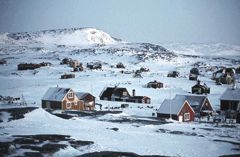
An Arctic community (Courtesy of www.bigfoto.com)
[NPR NEWSCAST: Boards of Canada “Zoetrope” from ‘In A Beautiful Place Out in the Country’ (Warp Records – 2000)]
CURWOOD: From the Jennifer and Ted Stanley Studios in Somerville, Massachusetts - this is an encore edition of Living on Earth. I’m Steve Curwood.
In certain villages in northern Greenland something is completely out of whack—only girls are being born. These reports from villages near the U.S. Air Force base in Thule are now being explored by scientists. But studies conducted a few years ago now coming to light show that in other Arctic regions, the sex ratios of babies are also out of kilter. In 2004 the Arctic Monitoring and Assessment Program found a correlation between exposure to PCBs and shifts in the sex ratios of babies born to indigenous mothers living in the northern reaches of Russia. PCBs and other persistent organic chemicals such as pesticides travel from industrial countries up the food chain into the blubber of marine mammals. Lars Otto Reiersen is the executive secretary for the Arctic Monitoring and Assessment Program. His group conducted the study as part of ongoing research on pollution, diet and health in the region.
REIERSEN: The most interesting and surprising result was that we saw a change in the sex ratio that we could correlate to the levels of PCB in the mother's blood. And we saw that if the mother had more than four micrograms per liter in her blood the average was to change two girls per boy in the population that we studied. And that's a quite dramatic change from a normal situation where there are more boys than girls born.
CURWOOD: Now when you say more boys than girls born, how many more boys than girls?
REIERSEN: I think normally—statistically—there is 1.05 or 1.1 boy per girl. That's the normal average.
CURWOOD: In this population though it's 2.0 girls per boy.
REIERSEN: Yeah, when the mothers have these levels of PCB, yeah. And we also saw that the birth came earlier and the weight on the newborn babies that had the highest levels were lower than the normal.
CURWOOD: Tell me about how you went about collecting your data. How did you find your subjects? Who were these people?
REIERSEN: Based on the study we'd done in Greenland and Canada we are focusing mainly on the indigenous people living off the marine food chain because we've seen that these people have the highest levels because of their lifestyle. And we worked together with the indigenous people to collect the samples over a year's period to get enough statistical data. And we have continued after that. The first report was published in 2004 and the new data just confirmed what we saw earlier. So what we're looking into now is to try to understand what is the mechanism behind it.
CURWOOD: Now, looking at your report here I'm just struck by the apparent effects that PCBs have on the sex ratio of children and the way it changes. The chart you have there, I'm looking at page 175. The chart that you have there shows that as you increase exposure to PCBs, at first you get way more boy babies than girl babies. But then as you go higher and you get above four micrograms per liter of blood you get way more girl babies.
REIERSEN: Yes, I can see that. And the scientists do not have any good explanation of why it looks like you have a stimulation at the lower levels and then you get the opposite effect when you go beyond that level. So, what we're doing now is that we're looking into the certain polar arctic to see—do we see any similar effects in Canada or Greenland?
CURWOOD: How might PCBs do this do you think?
REIERSEN: Well, it could be what we call the mimic of the hormones. That early in the pregnancy that some of these pesticides may mimic testosterone or estrogen. That's documented from science. So, that might be what's occurring but that's too early to say for sure what's the mechanism.
CURWOOD: Now, PCBs are concentrated in the arctic and concentrated in marine mammals. But what might this mean for the rest of us around the world who have exposure to PCBs but at a much lower level?
REIERSEN: That's a good question. PCB is all over, it's not only in the Arctic. You have it all over the world in the terrestrial and marine food chain, and in fresh water. So, from laboratory studies we know that PCBs may effect reproduction, may have effects on cancer and immune systems. But I think it's very difficult to document that on the population level. You have to have very detailed studies like the one we did in Chukotka area.

An Arctic community (Courtesy of www.bigfoto.com)
REIERSEN: Well, they have responded very active. I think you have got the Stockholm Convention in place to a far extent due to the work we have done in the Arctic over the years.
CURWOOD: And the Stockholm Convention is?
REIERSEN: That is an international agreement among countries to reduce the production and use and discharge of persistent organics. I think that is what you need actions to clean up the use of PCB and the old waste sites of PCB and others of these chemicals. That's important actions to be taken.
CURWOOD: Lars Otto Reiersen is the executive secretary for the Arctic Monitoring and Assessment Program. Thank you so much, sir.
REIERSEN: Thank you
CURWOOD: For a link to the Arctic pollution study, visit our website: L-O-E dot org.
Related links:
- The Arctic Monitoring and Assessment Programme
- To read part of the study concerning gender imbalance, click here
[MUSIC: dZihan & Kamien “Drophere (DV Remix)” from Live In Vienna (Six Degrees Records 2004) ]
From Toilet to Tap
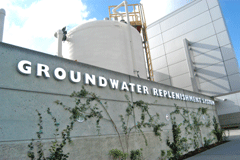
Orange County will soon use purified wastewater to replenish sinking groundwater. (Photo: Orange County Water District)
CURWOOD: Shortages of water in Southern California had officials looking in some unlikely—and perhaps unsavory—places.
[SOUND OF TOILET FLUSHING]
CURWOOD: The squeamish call it ‘toilet to tap.’ The correct term is ‘indirect potable water reuse.’ That’s a mouthful. And recently, 2.3 million people in Orange County California began quenching their thirst with it. Living on Earth’s Ingrid Lobet reports.
LOBET: It's the basic tenet of public health—keep your water and sewer separate. Yet Orange County water and sewage treatment officials have found the closer they work together, the better.
WILDERMUTH: Because of growing population, we knew that we need to put more water in the groundwater basin. And so 10, 13 years ago, we started looking around.

In reverse osmosis, water molecules are forced through plastic film. (Courtesy of Orange County Water District)
WILDERMUTH: So you had one water agency needing water. You had a sanitation district that was going to have to build another pipe to dispose of more water. So they came together and said ‘why don't we take that water, purify it, and then you won't have to build the ocean outfall.’
LOBET: It helped the decision along that the cost of electricity to clean wastewater was less than pumping water over the mountains from northern California, and also less than getting the salt out of seawater.
[SOUND OF FLOWING WATER]
HELLEBRAND: This water now is what will be sent over to the water districts. So we're at the end of the water process.
LOBET: Now, more than a decade later, Ingrid Hellebrand of the Orange County Sanitation District points with pride at her finished product—strained, settled, aerated and skimmed into a goldish but clear liquid. Hellebrand calls the stuff she deals with everyday ‘water.’ Does she really think of it as water?
HELLEBRAND: Yeah, it’s, it’s water!
LOBET: Well, 99.9 percent water. There is .1 percent of something else.
HELLEBRAND: When you flush the toilet, when you brush your teeth, the water just goes away. And nobody really thinks about where away is, but that’s where I work—where ‘away’ is. And the school kids come through, and they're kind of looking for that yuck factor. And by the time they get to the end of the process and they see that the water is so clean—you almost want to drink it! (laughs)
LOBET: And from here, the end of the sewage treatment process, it gravity-drains to the water utility, right next door. There, three things happen. None by itself is unique or too remarkable but taken together, and used on wastewater, it's the largest project of its kind in the world. First the water is sucked up into thousands of stringy straws with perforated sides.
[SOUND OF MICROFILTRATION]
LOBET: Bugs like protozoa and bacteria in the water can't fit though the holes. So every 22 minutes the airflow reverses to blow instead of suck, to clean the holes. The impurities are promptly sent back across the property line to the sewage treatment plant. Ron Wildermuth of the Water District loves the sound.
WILDERMUTH: It's like an orchestra.
LOBET: Music to your ears?
WILDERMUTH: Yes it is! (laughs)
LOBET: Next, the water passes though chambers for reverse osmosis. That means the water molecules are actually forced, under intense pressure, through a sheet of plastic. Wildermuth says not much besides tiny water molecules can pass through.
WILDERMUTH: If you size a water molecule the size of a tennis ball, your pharmaceuticals, hormones, pesticides—would be the size of a soccer ball. Okay? A virus would be the size of a tractor-trailer truck. So basically we’re physically not allowing viruses, uh, fertilizers, pesticides, hormones, or pharmaceuticals to get through because they can't get through the plastic sheet.
LOBET: Last, the water is exposed to ultraviolet light and mixed with peroxide. That zaps two compounds that manage to get this far for final cleaning. The engineers here at the water utility brought all this new equipment online over the last three months. The day before my visit had been a milestone. For the first time they'd injected their new purified water underground. William Dunivin is in charge.
DUNIVIN: To see it all come together after so many years it’s like, I can't explain it. And just the fact that it's such a, a timely event for the world to see this. I mean, with water becoming such an issue throughout the world. And this is a viable way to do it, and safely.
LOBET: A steady stream of visitors from around the globe tour the project. At home, it's been the focus of an intense public relations, okay, public education campaign. Again, Ron Wildermuth.
WILDERMUTH: We thought we could convince the people this was a good idea, and we did.
LOBET: How did you do that?
WILDERMUTH: Face to face talks for ten years to everybody that would listen. We talked to the historical society. We talked to the chambers. We talked to the flower committee. If there was a group, we talked to them.

Orange County will soon use purified wastewater to replenish sinking groundwater. (Courtesy of Orange County Water District)
WILDERMUTH: Very good water.
LOBET: For those not persuaded by the positive, consider this: many of us are already drinking water that was discharged as treated sewage into a river, and then tapped and purified downstream.
WILDERMUTH: Las Vegas puts like 200,000 gallons of wastewater in Lake Mead every day. And that comes down to us. It’s nothing new.
LOBET: But we haven't been talking that much about it.
WILDERMUTH: You're darn right we haven't. But, you know, it's a fact of life.
LOBET: For Living On Earth, I'm Ingrid Lobet in Fountain Valley, California.
Related links:
- Groundwater Replenishment System
- Orange County Sanitation District
- Orange County Water District
[MUSIC: Sergio Mendes “Agua De Beber” from Encanto (Concord Records 2008)]
CURWOOD: Coming up: a park ranger channels a Buffalo soldier in Yosemite National Park.That’s just ahead on Living on Earth.
[MUSIC: Brad Mehldau: “Things Behind The Sun” from Live In Tokyo (Nonesuch Records 2004)]
Northwest Dead Zone
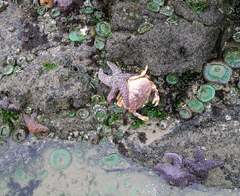
Seastars feasting on Dungeness crabs that succumbed to low oxygen conditions during 2004. (Photo: Jane Lubchenco)
CURWOOD: You’re listening to an encore edition of Living on Earth. I’m Steve Curwood. We like to picture the ocean as teeming with life – with fish and crabs and strange glowing eels. But in many parts of the world the ocean is dying. There are currently about 200 dead zones almost all of them caused by fertilizer or sewage run-off. But one dead zone off the coast of the Pacific Northwest has been expanding over the past few years, for causes that are harder to fathom. Joining me now is Professor Jack Barth of the College of Oceanic and Atmospheric Sciences at Oregon State University. Professor Barth, welcome to Living on Earth.
BARTH: Thank you, Steve.
CURWOOD: So the news is, the dead zone off of the Pacific Northwest might well be connected to climate change. How and why would that be?
BARTH: Well, we've seen low oxygen or hypoxia in these areas where there is significant green life die-off, so-called dead zones. We've seen that over the past five or six years, and we think that's unusual on the backdrop of about a fifty year's worth of data. So we're looking towards the cause, and we think there's a hint in the winds and how they're changing and how that affects these dead zones.
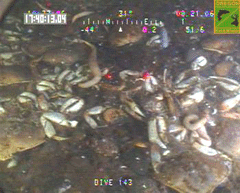
Screen capture showing carcasses of marine worms, sea cucumbers, crabs and other marine life killed by the loss of oxygen in nearshore reefs. (Photo: Oregon Department of Fish and Wildlife ROV)
BARTH: Well, this one's unusual because it's on an open coastline. It should be flushed regularly. There are no rivers putting nutrients in – that's the cause of most of the hypoxia zones around the world. Well it's all connected to the winds. The winds blow on the coast, they bring up these deepwaters from offshore, right in next to the coast. That fuels these phytoplankton blooms that then decompose and pull the oxygen out of the water. So we can go back to the winds, are the winds changing? And we know that with climate change there can be changes in the wind. Particularly they can increase in strength, so this whole scenario where we're producing lots of plankton that can decompose, that might be worse as we go into a climate change scenario.
CURWOOD: Why isn't this, you know, just something that's cyclical, that every ten or twenty, or maybe every fifty years this happens, the way you get other oscillations in the ocean, like the whole El Niño/La Niña phenomenon?
BARTH: Yeah, we were quite interested in that. There's a big ten-year change out here in the Pacific, and when we first saw this we said, ah ha that's just one of these ten-year swings. But having gone back over that fifty-year record, this recent five or six years really is unusual. So I can tell you that it's not part of a decadal, or a ten-year oscillation. Whether it's fifty or a hundred years, we don't know.
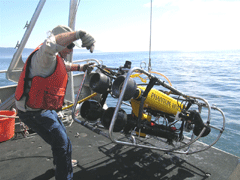
Dr. Hal Weeks deploying an Oregon Department of Fish and Wildlife robotic remotely operated vehicle to survey the effects of low oxygen zones along the Oregon coast. (Photo: Jane Lubchenco)
BARTH: Well, first thing you notice, there's lots of something called marine snow, this white, flocky material coming down from the surface. That's the plankton falling down that's gonna be decomposed and lead to the hypoxia. Next thing you notice is there aren't any fish in the area. So in all of our surveys in '06, we did not see any fish in this zone. Then you notice the piles and piles of Dungeness crab carcasses on the sea floor. Amongst them are sea worms that have come out from the bottom and are just flapping in the currents. Some of these majestic anemones, white, about two feet tall, starting to slump over from lack of oxygen. There usually are lots of sea star species. We saw some of those actually collapsing from lack of oxygen – so basically this wholesale area of nothing alive and lots of death.
CURWOOD: Going over a couple of articles written about your research, there was a story of some fisherman having crabs kind of jumping out of the water there? What's that all about?
BARTH: Yeah, what happens is those that can get away do. And what I saw myself is, my son and I go recreational crabbing, and we were in the bay near the dead zone and catching phenomenal sized crabs, sort of dinner plate sized in fifteen minutes or less. And those were the crabs that were running into shore, running into shallow water where there is oxygen. I've also heard reports of small octopi coming up the lines of the fisherman, trying to get out of that dead zone near the bottom of the water.
CURWOOD: And this isn't happening just off the Pacific Northwest. This is elsewhere on the planet.
BARTH: Yeah, we know of two other areas. There's – the area off Peru and Chile has a similar hypoxia zone. The one off South Africa and Namibia is quite interesting. They actually get walk-outs of lobsters onto the beach, fleeing the dead zone in that region.

Seastars feasting on Dungeness crabs that succumbed to low-oxygen conditions during 2004. (Photo: Jane Lubchenco)
BARTH: Yeah, that's exactly right. If you think about this whole process as fueling a healthy ecosystem, there was a balance there and now somehow we've pushed that a little too far, and as these dead zones develop the creatures are fleeing to the edges looking for oxygen refuges and concentrating, and we're really not sure what the ripple effect will be – will they be more subject to being preyed upon in those areas?
CURWOOD: Professor Jack Barth teaches at the College of Oceanic and Atmospheric Sciences at Oregon State University. Thanks so much, Jack.
BARTH: You're welcome, Steve.
Related link:
Click here to see more photos and read the Oregon State University team's work
Dial-A-Fish
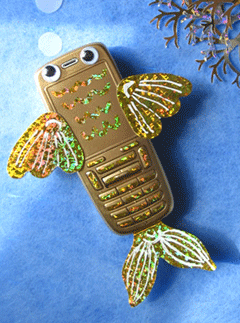
Not this kind of fish phone! (Photo: Sue Allen)
CURWOOD: When you’re in a restaurant or a grocery store, thinking about fish for supper, you might also want to think about what could be in the fish—maybe mercury, perhaps PCBs? Or maybe the fishery is floundering. Some fish are good—some not—but can you remember which fish is which? Now you don’t have to—you can let your fingers do the fishing, as Living on Earth’s Ashley Ahearn learned when she dialed-a-fish at her local supermarket.
[SOUNDS OF GROCERY STORE, BEEPING, PEOPLE WALKING]
AHEARN: So I’m going to type in ‘swordfish’ and see what comes up.
[CELL PHONE TEXT MESSAGE SOUND]
AHEARN: It says; Atlantic and Mediterranean caught, few environmental concerns. It got a green rating. And they’re high mercury, though. Okay, so maybe I won’t do swordfish. I’m trying salmon now.
[CELL PHONE TEXT MESSAGE SOUND]
AHEARN: But for wild salmon it says it’s fine. So I guess farmed salmon is off the menu for dinner, too.
So yeah, that was me with my cell phone, talking to myself at the local market. As crazy as I might have looked, though, this service is really cool. It’s called Fish Phone. The guy who dreamt it up is Carl Safina, head of the Blue Ocean Institute. I called him to find out how it works.
SAFINA: You simply send a text message with the word ‘fish’ and the name of the fish that you are interested in and virtually instantly, you will get a beep on your phone and you will see whether you should tell the waiter that that’s what you want to eat or you should tell the guy behind the counter or the woman behind the counter that that’s what you want to buy.
AHEARN: So it’s kind of like cheating in a way.
SAFINA: Uh, it’s kind of like being a very informed consumer and feeling kind of smug about it.
AHEARN: Carl Safina and his team have put together a database that rates each fish based on pollution exposure, fishing practices, population levels, even how long it takes that species to reproduce.
SAFINA: And then we score all those things and then we relate the score to a color code and the code sort of ranges from green to light green to yellow to reddish yellow to red.
AHEARN: I think Dr. Seuss wrote a poem about that.
SAFINA: Yes, he did (laughs). Maybe subliminally that was our inspiration all along.
AHEARN: But beyond the rating system, Carl has some basic rules of thumb for anyone buying fish, even if they don’t have text messaging on their phone.

Not this kind of fish phone!(Photo: Sue Allen)
[SOUND OF GROCERY STORE, BEEPING AND PEOPLE TALKING]
AHEARN: That doesn’t really help me for dinner, though. Swordfish is a little bit out of my price range. But Safina says farmed shellfish is good. So, I’ll text the number 30644, the word ‘shrimp,’ and let’s see what my phone spits out now.
[CELL PHONE TEXT MESSAGE SOUND]
AHEARN: Oh, okay, so if I get farmed shrimp, I’m okay, it looks like, from here. So shrimp it is for dinner. Thank you Carl Safina. Thank you Fish Phone. Alright, great. Can I get a half a pound of the farm-raised—
For Living on Earth, I’m Ashley Ahearn.
[MUSIC: Taj Mahal “I’m A Goin Fishin” from The Real Thing (Sony Music 1971)]
Related link:
The Blue Ocean Institute: Guide to Ocean Friendly Seafood
Interpreting History
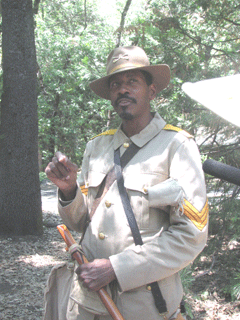
Park Ranger Shelton Johnson becomes Sergeant Alizy Bowman to tell the history of the beginnings of Yosemite National Park. (Photo: Melissa Frank)
CURWOOD: Two hundred and fifty million Americans visit our National Parks every year. We have nearly 400 of them in all. Most of them are patrolled by rangers who protect the park and talk about its geography, geology, plants and animals. And some feature interpretive rangers, who take on a character to help visitors understand the unique history of the park. One such ranger welcomes visitors to one of the most beautiful spots in the West, Yosemite. Jim Williams of member station KUMN caught up with this ranger in action.
JOHNSON: Have you noticed there’s just so much sky here? I think there’s a overabundance of sky in Yosemite. I wonder if the sky needed to get a permit from the government to have so much of itself over here.
WILLIAMS: South Carolina native Sergeant Alizy Bowman stands surrounded by fifteen or so wide-eyed Yosemite visitors. He’s decked out in his tan 9th cavalry finest. The crossed swords on his brimmed military hat flash in the bright sunlight.
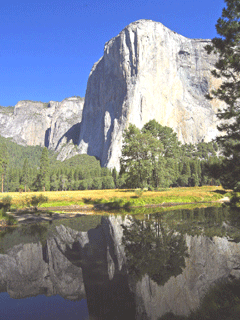
One of Yosemite's best known landmarks: El Capitan (Photo: Jon Sullivan)
WILLIAMS: Everyone in this group raises a hand. It’s not surprising: Bowman is using Half-Dome as his own personal backdrop—the nearly-vertical granite cliffs shine through the massive incense-cedars and ponderosa pines on the Yosemite Valley floor. And of course, this isn’t really Sergeant Alizy Bowman. It’s Shelton Johnson, an African-American Interpretive Ranger who’s essentially reincarnated the sergeant’s character. In fact, Johnson’s been getting into this character in front of visitors here for about five years now. From his research, Johnson found out that Sergeant Bowman was a Buffalo soldier, a member of a group of African-Americans who helped guard Yosemite just after its creation. Bowman spent several summers in the early 1900s patrolling the backcountry looking for poachers and timber-thieves.
JOHNSON: And the people in this county—Mariposa County—are used to coming up into these mountains and getting what they want, what they need to help their family from these mountains. People come up here, and have for years, to shoot the game, to cut the trees down for firewood, and all of a sudden, the government steps in and says that there’s a line right here. Right here. And that line, on this side, is Yosemite National Park. On that side is Mariposa County. Now how many of you see that line? If you from Mariposa County, there ain’t no line there at all.
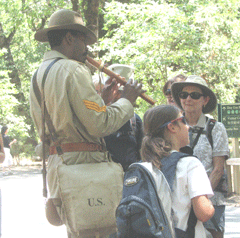
Sergeant Alizy Bowman, aka Ranger Shelton Johnson, plays his flute for Yosemite National Park visitors. (Photo: Melissa Frank)
JOHNSON: I gotta ask you folks something: is there a nice way to call someone a timber thief and a poacher? And if we were in Mississippi, or Alabama, or Georgia, and I was gonna call a white man a timber thief and a poacher, ain’t there a word for that down south? Oh, I remember, it’s called suicide.
[LAUGHTER]
WILLIAMS: The laughter turns to quiet, and there’s a moment here where Johnson’s audience seems to consider something a bit deeper, but the ranger moves them on quickly to another spot, playing his Native American flute along the path.
[FLUTE MUSIC]
WILLIAMS: He stops, points to a place for the kids to sit in the shade, and Alizy Bowman is back.
JOHNSON: Man, do you think I got a bit of a attitude?
WILLIAMS: He explains that he’d had an attitude growing up in Spartanburg, South Carolina, which didn’t go over well in the late 1800s. It’s a big part of the reason he ended up a Buffalo Soldier. His father, he says, told him to leave home as a teenager and walk north, which he did. Then he went west, eventually ending up in Fort Robinson, Nebraska, where he was extended an offer to join the Army. Bowman says as he held the pen to sign his enlistment form, he remembered that his brother had died in the Civil War, after having escaped slavery in South Carolina.

Park Ranger Shelton Johnson becomes Sergeant Alizy Bowman to tell the history of the beginnings of Yosemite National Park. (Photo: Melissa Frank)
WILLIAMS: Johnson bases his performance on his late father’s personality, and says through the performance, his father, and the Buffalo Soldiers, live on.
VISITOR: Thank you so much!
JOHNSON: You’re welcome. Thank you.
WILLIAMS: And for the visitors here today, none of whom are African-American, the impact is clear.
MAN 1: This man has a true gift as a storyteller. I would come back every day to hear this if I could. I feel like I’m a lot better educated about it, and I really appreciate that.
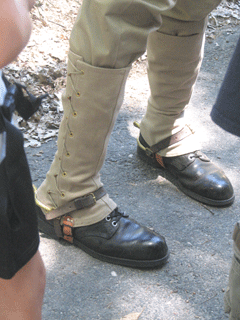
The intricate lacing of the spats of Sergeant Alizy Bowman's 9th cavalry uniform. (Photo: Melissa Frank)
JOHNSON: It’s a secret.
MAN 2: Yeah, I figured it was a secret. He just acts the part really, really well.
WOMAN: It just makes it a much richer experience than having, you know, someone tell you about history, it gives you the feeling of experiencing history.
MAN 3: And I think the country’s probably full of stories like this if we really knew the history and the individuals who were involved in these things.
WILLIAMS: Johnson says for him, the opportunity to share Bowman’s character with park visitors is too good to pass up.
JOHNSON: I think that this story provides a cultural window. A window into another way of looking, into another way of being—that some people have never looked through that particular window. And so this provides them an opportunity to not just see another person’s point of view, but to see themselves through that other window, how they may be seen through that other window.
WILLIAMS: But Johnson believes he’s also having an impact on African-American park visitors.
JOHNSON: They come into this setting and there may be some anxiety, because it’s away from urban areas. They’re doing something that a lot of African-Americans historically have not done in terms of visiting national parks and wilderness areas. And so when they hear this story, it’s like a safe-house, or an environment of not necessarily comfort, but it gives them a sense that ‘oh we belong here, this is the place that we’ve done this work, that we helped protect. This is our park.’ And they start seeing Half Dome, they start seeing El Capitan in a completely different way, because now it’s part of the African-American experience, to be in Yosemite.
WILLIAMS: Johnson regularly does his Alizy Bowman presentation for kids of color from nearby places like Fresno, Los Angeles, Sacramento, and San Francisco. The kids come to understand that some of Yosemite’s earliest protectors faced some of the same challenges they face today. Johnson says, for him, it’s also a way to make sure the history book isn’t missing a chapter.
JOHNSON: I think that stories that are forgotten, that we pay no attention to, just fade away, like an old soldier, you know? But stories that get that attention, that engage the mind, that engage the vision, that invigorates the story, that puts blood into the story, and the story can just live and live on and live on and live forever.
[FLUTE MUSIC]
WILLIAMS: And to help ensure just that, Shelton Johnson is writing a book on the Buffalo Soldiers of Yosemite. It’ll be called “Gloryland.” He’s also been interviewed by Ken Burns for a PBS documentary on the parks. His is a rising star, and Alizy Bowman is right there rising with him.
For Living On Earth, I’m Jim Williams from Yosemite National Park.
Related link:
Yosemite Interpretive Ranger Shelton Johnson's Shadow Soldier website
[MUSIC: Monty Alexander “Buffalo Soldier” from Concrete Jungle (Telarc 2006)]
Global Weirding
CURWOOD: Coming up: the year of eating locally. Pass the beets and rhubarbs, please. Stay tuned to Living on Earth!
ANNOUNCER: Support for the environmental health desk at Living on Earth comes from the Cedar Tree Foundation. Support also comes from the Richard and Rhoda Goldman Fund for coverage of population and the environment. And from Gilman Ordway for coverage of conservation and environmental change. This is Living on Earth on PRI—Public Radio International.
CURWOOD: It’s an encore edition of Living on Earth. I'm Steve Curwood. And now, a few words from our listeners.
[LETTERS THEME]
CURWOOD: Recently, we asked you if you could come up with better terms than "global warming" and "climate change." You certainly had some ideas:
IAN QUIRK: I think it should be climate imbalance, which implies some places are gonna get much hotter and some places are gonna get much colder, but either way we have no way of predicting how that's going to happen.
BONNIE BISHOP: What to call global warming instead of global warming? And from the beginning, I've said we should call it global trauma.
LEON FROM CHICAGO: The topic of the climate change, how it should be called – well, it should be called climate change.
MARTIN SLOVINSKY: Human consumption climate disruption; human consumption climate disruption
CURWOOD: Your e-mails also think 'global.' There was 'global life system instability' and 'global climate disruption,' 'global climate damage' and 'global climate melt-down.' One writer suggests 'global temperature destabilization,' noting that it's 'harder to say and spell, but more descriptive.' Also pretty hard to say is this offering – anthropogenic climate disruption. And still the phones kept ringing off the hook:
PETER WALE: In our household, when we run into difficulties with the terms global warming or climate change, we resort to a more technical term, ebbifluid acceleration.
AHMEEL MERRITT: How about we call it global abuse?
ANNA VON BILLINGEN: The new suggestion for what we're calling how we're trashing our planet would be global dumping.
CARBON INFUSION: I heard a good one. It sounds right to me – carbon infusion. Deadly carbon infusion.
CURWOOD: Many thanks to all who took the time to call and write, including Ian Quirk, Anita Schnee, Martin Slovinsky, Ahmeel Merritt, Bonnie Bishop, Jack Ciak, Peter Wale, Terry Watts, and Anna Von Billingen. We're always glad to hear from you. You can call our listener line any time at 800 218-9988. That's 800-218 99 88. Or you can always write to us at Living on Earth, 20 Holland Street, Somerville, Massachusetts 02144. Our e-mail address is comments at LOE dot org. Once again, comments at LOE dot org. And visit our web page at L-O-E dot O-R-G. That's L-O-E dot O-R-G.
Life As a Locavore
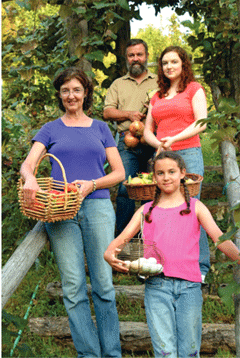
Barbara Kingsolver and family. (Photo: Hank Daniel)
CURWOOD: Barbara Kingsolver left life in the farm country of Kentucky in the 1970s to become educated as an evolutionary biologist. But what she didn’t know was that she would also become a best-selling novelist. You may know some of her titles: “The Poisonwood Bible” is one “Prodigal Summer” is another. Now she and her husband and daughter have a volume that documents how her family carried out a vow to eat only locally grown food for one year. The book is called “Animal, Vegetable, Miracle; A Year of Food Life.” Her family produced about seventy percent of what went on their table from their own farm in Virginia—everything from tomatoes to turkeys.
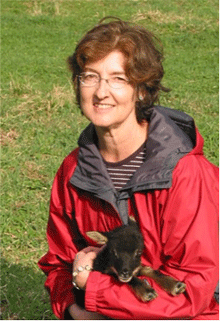
Barbara Kingsolver and a lamb born on her Virginia farm. (Courtesy of Barbara Kingsolver)
KINGSOLVER: We were led into this project for so many reasons. For me, it’s because I grew up in a rural community among farmers and I’ve always considered the local farming economy to be important and frankly an important part of food security. We are now, as a nation, putting almost as much fossil fuels into our refrigerators as our cars. Every item on average on the American plate has traveled 1500 miles so add up all the items on your plate and you might as well order room service from the moon!
That’s an incredible amount of fossil fuel, an incredible amount of carbon emissions going into the atmosphere, warming up the globe just to get a grape from Chile, a tomato from Mexico so I can eat a tomato in January.
CURWOOD: Now, you write in your book that 80 percent of us in America would love to eat organic and locally grown foods yet the American government through the farm bill gives just about all federal money to the biggest farms in the country and most of them grow things like corn, soybeans, and wheat far from where most of us live. Can you talk to me more about that?
KINGSOLVER: I’m so glad you brought that up. U.S. taxpayers pay tens of billions of dollars every year to subsidize the production of commodity crops which are, as you mentioned, mostly corn wheat and soybeans. Most of that production enters our diets without our notice as the ingredients of processed foods like high fructose corn syrup and feed to raise cattle and hogs. And we also as taxpayers subsidize the fuel costs of getting these products manufactured and shipped to the market.
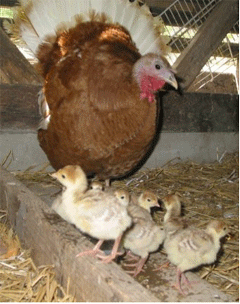
Kingsolver keeps a breeding flock of rare heritage Bourbon Red turkeys. (Courtesy of Barbara Kingsolver)
CURWOOD: About what did it cost you to grow your own food and buy the rest of it locally?
KINGSOLVER: You know what, we were stunned by the answer to that question. I kept really careful records and I found out that we spent about 50 cents per person per meal to eat as splendidly as we did in this year. And I thought this must be a mistake so I went back and I recalculated and that was it: 50 cents per person per meal.
CURWOOD: So, for those of us that are used to having orange juice for breakfast, how were you able to pull this off? I mean eating locally, growing it yourself or getting it from local farmers means for example you’re not going to have orange juice for breakfast there in Virginia.
KINGSOLVER: You start by accepting this will be a paradigm shift. This will be a change in the way you think about food and as time went by we really learned to stop asking the question, what do I want right now? And instead start seeing each week as something like the menu in a restaurant: Look at what’s available. What do they have? What’s growing this week? What’s fresh and delicious and choose from that.
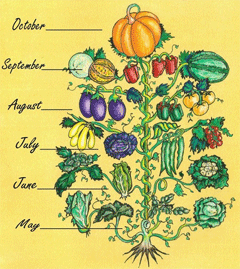
The “vegetannual,” a term invented by Barbara Kingsolver to describe when fruits and vegetables are in season. (Courtesy of Barbara Kingsolver)
CURWOOD: Now you were a vegetarian for many years but as part of this project you decided to raise and slaughter your own meat. Talk to me about how and why you came to that decision.
KINGSOLVER: It’s really important to know that food is not just a product but a process. There are two very different ways of producing meat. One of them is concentrated animal feeding operations or CAFOs. These are feed lots for cattle or metal windowless warehouses for hogs, turkeys, chickens and so forth where they’re crowded as close as they possibly can be and these very concentrated populations require that all of their food be milled and processed somewhere else and brought in and then all of the concentrated waste have to be trucked out to somewhere, heaven only knows where. And these animals get fed this porridge of the cheapest ingredients just for the efficiency of producing cheap meat. And also they have to be given antibiotics in order to keep them alive under conditions of extreme physiological stress. So that kind of meat I hadn’t eaten for many years.
There is another way, a different way of raising meat, and that is keeping these animals on pasture. And the interesting thing from an energetic point of view is that they can do all this without using a drop of gasoline. In the county where I live we have a lot of steep grassy pastures. And we can use this as a solar-powered industry to make meat. And that’s the food that my grandparents got through the winter on and we felt that we could do the same and we even raised turkeys and chickens of our own.

Barbara Kingsolver and family. (Photo: Hank Daniel)
KINGSOLVER: Yeah.
CURWOOD: And you’d only been at this a little while. I mean you didn’t have last year’s canned goods or anything stuck in your freezer that you could trot out here.
KINGSOLVER: Right. We began thinking this is a pretty bleak time of year. May is still pretty early where we live in the mountains of southern Appalachia. There’s not a lot coming up just yet. And we were thinking, oh this is going to be the borsht party beets and potatoes. But as a matter of fact as happened over and again in this project, what we found was so much more than we were looking for. There were terrific salad greens. There were asparagus there were eggs so we could have asparagus frittatas. There was rhubarb and strawberries so we could have strawberry rhubarb crisp. There were lamb and oh wow we had chicken pizza. There was so much that was just literally down the road from where we lived, so much more than we expected. And it turned out to be a terrific event because it reinforced to us this isn’t a story of deprivation. This is a story of gratitude.
CURWOOD: Now, where you are in Virginia, you’ve got a farm, a lot of neighbors who are in the food business. But what about somebody who lives in say the city or say a colder climate. What kind of advice would you offer for taking steps to eat more locally?
KINGSOLVER: Being thoughtful about food life is not of course about growing your own. Anyone who has choices about food can exercise them with more care even in the cities and especially in the cities. Every grocery store that carries multiple brands will have some that are produced closer to home than others. We can all emphasize whole ingredients more and pass up processed goods that have so many hidden costs. And the next stop of course is the farmer’s market. More than half of all of us living in the US live within striking distance of a place where farmers sell their own produce. Also many cities have community gardens. I think there are 114 of them in Manhattan alone. Any way you cut it getting to know your own food chain is neighborly and it’s healthy. It keeps your money in your own community and it keeps the land around you a little more green.
CURWOOD: So you eat locally for a year and you lived to tell about it and the day this project was finished did you run out for what uh maybe uh…
KINGSOLVER: Coca Cola and moon pies? No, we didn’t. We forgot to notice the day the project ended. By this time it was just the way we lived. We have a new relationship with where we live. We are what we ate.
CURWOOD: Barbara Kingsolver’s new book is Animal, Vegetable, Miracle; a Year of Food Life. It was written with her husband Steven L. Hopp and daughter Camille Kingsolver. Barbara, thank you so much.
KINGSOLVER: Thank you, bye.
Related links:
- For recipes and a tour of the farm, click here
- Barbara Kingsolver’s website
- USDA Farm Bill Website
- To find community-supported agriculture in your area click here
- Edible Communities Website
Eco Tunes
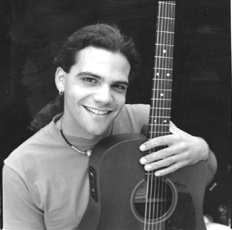
(Photo: Linda Wan)
[MUSIC: “Tree Hugging Song” from Children Of The Earth: Environmental Songs for Kids Of All Ages (Joe Reilly Music 2007)]
CURWOOD: How could we live without trees? That’s the question singer-songwriter Joe Reilly, and the youngsters he works with in Ann Arbor, Michigan, ask in that “Tree Hugging Song.” It’s from a new CD he’s produced, called “Children of the Earth.” Joe Reilly wants to spread the word about good environmental stewardship.
But he wants to entertain as well, with songs about nature, and animals, of all kinds.
[MUSIC: Joe Reilly “If I Could Be Any Tree” from ‘Children Of The Earth: Environmental Songs For Kids Of All Ages’ (Joe Reilly Music—2007)]
REILLY: My parents are both musicians. They’re both singers, and my dad plays the upright bass, as well. And they both play guitar. And so I grew up, really, literally, since I was in the womb with music all around.
REILLY (singing): …. Amphibitti – phibitti-phibitti-an…. Amphibitti – phibitti-phibitti-an …..(fades under) [Joe Reilly: “Amphibians” & Mammals are from a live performance for LOE]
REILLY: On the CD I really wanted to include the kids’ voices as part of the message, and as part of the expression. And so, I invited the kids to sing with me on several of the songs and then, I also interviewed them. I just wanted to give them a voice because I feel like, you know, the small voices are not heard and I wanted to give a little space on my project for those voices to come through.
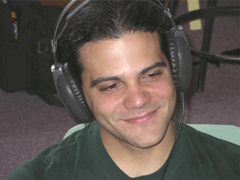
(Photo: Chris Reilly)
CHILD 1: You should ride your bike in the summer or whenever it’s warm enough to ride your bike instead of using a car because it’ll give you exercise and it will help the Earth.
CHILD 2: to use cars that use sunlight and no gas.
CHILD 3: using public transportation is better because it keeps more cars off the road.
CHILD 4: try walking.
REILLY: My hope is that those voices can help remind adults that we need to really take responsibility for our actions and how they’re affecting other people and other plants and living things and the future generations.
REILLY: (singing) Dogs, cats, hedgehogs, camels, these are all animals known as mammals. Horses, rabbits, humans, too, that’s right, I’m a mammal…..(fades under) [“The Animal Song” from Children Of The Earth: Environmental Songs for Kids Of All Ages (Joe Reilly Music 2007)]
REILLY: I guess sometimes I’ll sit down with a group and say “What do you want to write a song about?” and then they may shout out something like “mammals” for instance. So, okay, so we have a topic – mammals – and so, describe to me what a mammal is. You know, tell me, what are different examples of mammals, what are the habitats that mammals live in?
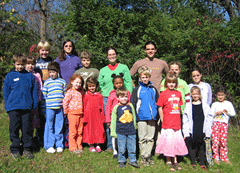
Joe Reilly and children from the Leslie Science and Nature Center in Ann Arbor, MI at the "Children of the Earth" recording session. (Photo: Francie Krawcke)
REILLY: I was thinking about, you know, the process of songwriting. It’s kind of a hard process to describe but working with kids and writing songs has been really helpful to me. I’ve learned a lot about how to just be open to possibilities that I might not have thought of when first starting to write the songs.
REILLY (singing): I am a crow, and I sound like CAW, CAW…(KIDS JOIN IN) We are all brothers and sisters…
REILLY: It’s my hope that this album, that this project can be a source of connection for kids. That it can help them build relationships to the Earth that are sustaining for the Earth, but also for the kids, for the kids’ sake.
REILLY (singing): I am a little kid, I live in Michigan….

Joe Reilly. (Photo: Linda Wan)
REILLY (singing): We are all brothers and sisters, we are all related.
CURWOOD: Joe Reilly is an environmental educator at the Leslie Nature and Science Center in Ann Arbor, Michigan. Check out our website loe.org for more information about Joe.
Related link:
Joe Reilly's website
[“Eastern Screech-Owl” recorded by Lang Elliott for ‘A Guide To Night Sounds’ (Nature Sound Studio – 1992)]
CURWOOD: You might say the Eastern Screech Owl lives up to its name with its range of calls, including the whinny. Lang Elliott of Nature Sound Studios recorded these wise-beyond-their-ears sounds.
[“Eastern Screech-Owl” recorded by Lang Elliott for ‘A Guide To Night Sounds’ (Nature Sound Studio – 1992)]
CURWOOD: Living on Earth is produced by the World Media Foundation. Our crew includes Ashley Ahearn, Bobby Bascomb, Eileen Bolinsky, Ingrid Lobet, Helen Palmer, Mitra Taj and Jeff Young, with help from Sarah Calkins and Marilyn Govoni.
Our interns are Luke Borders, Kim Gittleson and Jessica Ilyse Smith. Jeff Turton is our technical director. Alison Lirish Dean composed our themes. You can find us at LOE dot org. I’m Steve Curwood. Thanks for listening.
ANNOUNCER: Funding for Living on Earth comes from the National Science Foundation, supporting coverage of emerging science, and Stonyfield Farm: organic yogurt and smoothies. Stonyfield pays its farmers not to use artificial growth hormones on their cows. Details at stonyfield.com. Support also comes from you our listeners, the Ford Foundation, the Town Creek Foundation, and the Oak Foundation supporting coverage of climate change and marine issues, the Rockefeller Foundation and its campaign for American workers, more at rockfound dot org. And Pax World Mutual Funds: socially and environmentally sustainable investing. Pax World: for tomorrow. On the web at paxworld.com.
ANNOUNCER 2: PRI: Public Radio International
Living on Earth wants to hear from you!
Living on Earth
62 Calef Highway, Suite 212
Lee, NH 03861
Telephone: 617-287-4121
E-mail: comments@loe.org
Newsletter [Click here]
Donate to Living on Earth!
Living on Earth is an independent media program and relies entirely on contributions from listeners and institutions supporting public service. Please donate now to preserve an independent environmental voice.
NewsletterLiving on Earth offers a weekly delivery of the show's rundown to your mailbox. Sign up for our newsletter today!
 Sailors For The Sea: Be the change you want to sea.
Sailors For The Sea: Be the change you want to sea.
 The Grantham Foundation for the Protection of the Environment: Committed to protecting and improving the health of the global environment.
The Grantham Foundation for the Protection of the Environment: Committed to protecting and improving the health of the global environment.
 Contribute to Living on Earth and receive, as our gift to you, an archival print of one of Mark Seth Lender's extraordinary wildlife photographs. Follow the link to see Mark's current collection of photographs.
Contribute to Living on Earth and receive, as our gift to you, an archival print of one of Mark Seth Lender's extraordinary wildlife photographs. Follow the link to see Mark's current collection of photographs.
 Buy a signed copy of Mark Seth Lender's book Smeagull the Seagull & support Living on Earth
Buy a signed copy of Mark Seth Lender's book Smeagull the Seagull & support Living on Earth

